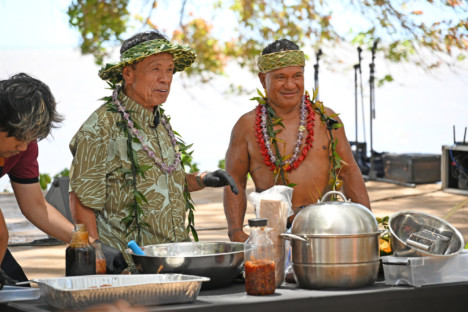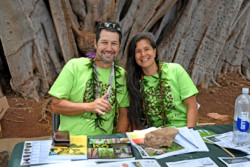Molokai ‘Ulu Fest
By Léo Azambuja
The Molokai ‘Ulu Fest last week celebrated the versatility of this highly productive, climate-resilient starchy fruit that grows on trees and is considered one of the most productive crops on Earth.
“The intention behind the event is to celebrate all things ʻulu,” ʻĀina Momona event coordinator Mercy Ritte said.
A couple hundred people came to Molokai Community Health Center Saturday morning to the event highlighting ‘ulu, also known as breadfruit. Just like in past events hosted by ʻĀina Momona, the focus is on food security, food sovereignty and food independence, always highlighting traditional and locally grown foods, Ritte said.
“There’s so many uses of ʻulu, and so we are highlighting all of that here at the event, and how you can make lei and food, savory food, sweet food,” Ritte said “It’s a nutrient-dense food, and we’re just wanting to encourage to eat ʻulu.”
The event was for the whole ʻohana, offering keiki activities, educational food booths, lei-making workshops, T-shirt printing, live music, lomi-lomi massage, local crafts and many food booths.
Several organizations were also there doing outreach, including Sustʻainable Molokai, Molokai Invasive Species Committee, Office of Hawaiian Affairs, Friends of Molokai Public Library, Kaneokana and others.
Vegan chef and cookbook author Lilian Cumic made an ice cream with ʻulu, dragon fruit and bananas.
“She creates amazing dishes out of plant-based ingredients, and uses a lot of local ingredients,” Ritte said.
Renowned chef, restaurateur and TV celebrity Sam Choy, widely known as the “Godfather of Poke,” brought his whimsical style, partnering with Samoan cultural expert, artist and entertainer Kap Teʻo-Tafiti to keep the crowd entertained — and well fed, of course, with a couple different culinary creations with ʻulu.
Dana Shapiro, of the Hawaiʻi ʻUlu Cooperative, said 99% of the staple foods in Hawaiʻi — potatoes, rice and wheat — are imported.
“In order to become more self-sufficient in the most important food group, staple foods, ʻulu is the best answer we have. It’s the best solution because the trees are already very well adapted to Hawaiʻi,” Shapiro said.
Additionally, she said, it’s a traditional Hawaiian crop, so it helps perpetuate culture and history, and it’s very easy to use.
“It’s just like a potato. So, I think that ʻulu is the backbone of Hawaiʻi’s sustainable food system. And if we want to be resilient, then ʻulu is a very big part of the answer,” Shapiro said.
Besides being a locally available crop, ʻulu has added health benefits, according to Ritte. It is gluten-free, low on the glycemic index, and beneficial for diabetics, she said.
Ritte said she hopes to make Molokai ʻUlu Fest an annual event.
“We need to plant a tree in every yard,” Ritte said, adding she would love to distribute ʻulu trees in future events. “We’ve got to eat more of our local traditional foods.”
The Molokai ʻUlu Fest was sponsored and hosted by ʻĀina Momona through an OHA grant. The Molokai Arts Center and Sustʻainable Molokai — through the Kamehameha Schools’ Kaiāulu grant — were co-sponsors.













Don't have a Molokai Dispatch ID?
Sign up is easy. Sign up now
You must login to post a comment.
Lost Password